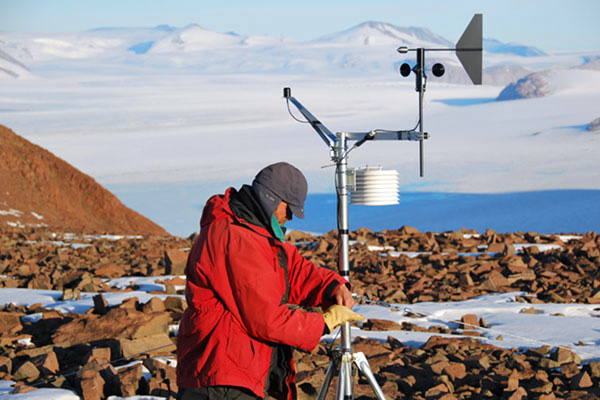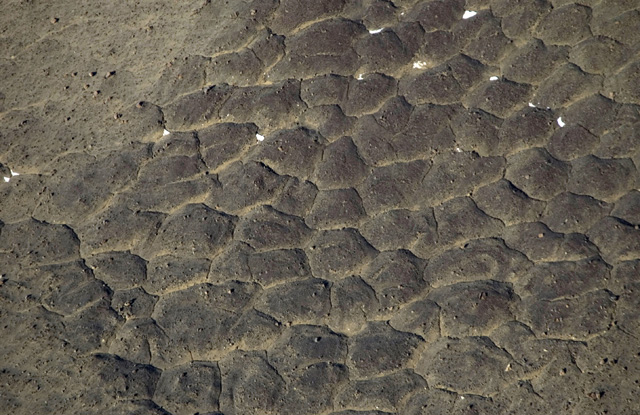|
Page 2/2 - Posted March 13, 2015
Features in McMurdo Dry Valleys inform studies on MarsVolcanic ash can be found in abundance in the upland Dry Valleys – if you know where to look. Deposits are draped over buried soils, trapped in troughs between ancient polygons, and mixed in with sediment. In the skilled hands of Marchant and his team, volcanic ash turns the landscape into a giant time machine. Once dated, the age, distribution, and weathering state of each ash deposit provides a chronology of geological events extending back millions of years. Marchant and his students have used the dating of volcanic ash, as well as other techniques, to decode some of the most significant geological events and climate transitions that have shaped the modern-day world. In 2007, Marchant led a team, which included former BU graduate students Adam Lewis and Jane Willenbring (now assistant professors at North Dakota State University and University of Pennsylvania, respectively), to study one of the largest climate shifts of the Cenozoic Era, which covers the past 65 million years of geologic history: the Middle Miocene Climate Transition. They found and documented well-preserved fossils of tundra, moss, and insects sandwiched between layers of volcanic ash dated to 14.1 million years ago. 
Photo Credit: Prehensile Productions
Sean Mackay exposes ancient glacier ice below a thin layer of rock and debris.
The fossils provided evidence for much warmer conditions than exist today, with reconstructed summertime temperatures at the fossil site of 5 degrees Celsius, and an environment similar to Patagonia at the southern tip of South America. The current summertime temperatures at the fossil site are about minus 23C. Just above the fossils, in a layer dated with volcanic ash as much as 13.9 million years old, the team found geologic evidence for dramatically colder and drier conditions. Climate reconstruction indicated summer temperatures well below freezing. Perhaps even more striking, says Marchant, is that the team found no evidence in the geological record for a subsequent return to warm conditions. The Middle Miocene Climate Transition they documented for Antarctica cooled the entire planet, and sent interior East Antarctica into a perpetual deep freeze from which it has yet to emerge. In addition to looking for data on past climate, the team collects records of modern climate by using meteorological sensors that track wind speed, air temperature, soil moisture, soil temperature and solar insolation. Toward the end of the trip, they connect their laptops to the sensors (they make sure the laptops are warm enough to function by wrapping them inside their coats) and download the data. Some of the sensors will remain in place on tripods anchored to the ground with wire and stakes until the team returns next year to collect more data. The story of the ancient ice, which relies on scattered, broken, and buried elements, is still very much emerging. “It’s like you have a puzzle that someone’s put together,” Sean Mackay, a doctoral candidate in geomorphology who has made several trips to the Dry Valleys with Marchant. “Then another person smashes it, it falls off the table onto the floor. There are some elements of it still put together, but 90 percent of it is missing.” 
Photo Credit: BU Antarctic Research Group
David Marchant adjusts guide wires supporting one of the team’s remote meteorological stations.
Back in Boston, in the lab, they unpack their crates of samples – as much as 1,000 kilograms of rocks, volcanic ash, sediment, cores of ancient ice – and begin viewing the reams of data they’ve spent weeks collecting in the field. What does it all mean? Just how old – how many millions of years – are the samples? How do these new clues fit into the narrative of past climate change and Antarctica’s Dry Valleys, and what can they tell us about potential future changes? In recent years, Marchant’s team has been applying his Antarctica research to questions about climate change and ice ages on Mars. They have found evidence for shallow, buried ice; debris-covered glaciers in craters; and huge ice sheets formerly occupying the Tharsis region of equatorial Mars. They have also mapped the impact of recent climate change on distribution of ice on Mars. Working with Brown University colleague James W. Head, Marchant says these studies now help inform their understanding of landscape evolution and climate change in Antarctica. With the presence of shallow ice on Mars, and the recognition that Mars experiences alternating ice ages, the question arises: What about life on Mars? Marchant and his colleagues are making progress here as well. In addition to ancient atmosphere, buried ice in the Dry Valleys contains ancient microbes, many entombed for millions of years. With colleagues from Rutgers University, Marchant has found that some of the ancient DNA inside the microbes can be cultured, meaning the cells can be made to grow again under controlled conditions. These studies have helped define the factors that allow cells to remain viable over geologic timescales. This has led Marchant and his team to another question: If life on Earth can persist in ancient ice for millions of years, then could the ice buried just below the surface of the Red Planet offer clues about past life on Mars? And, if ancient DNA is found on Mars, could it be resurrected? [For more on this story, including video interviews with David Marchant, see The Search for Ancient Ice |



For USAP Participants |
For The Public |
For Researchers and EducatorsContact UsNational Science FoundationOffice of Polar Programs Geosciences Directorate 2415 Eisenhower Avenue, Suite W7100 Alexandria, VA 22314 Sign up for the NSF Office of Polar Programs newsletter and events. Feedback Form |


